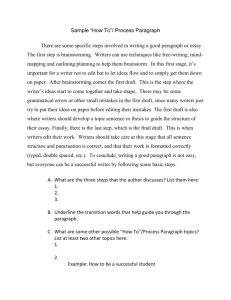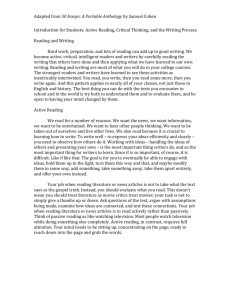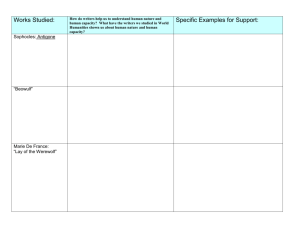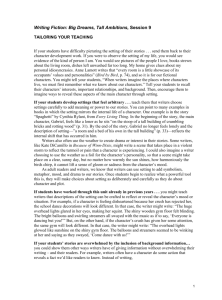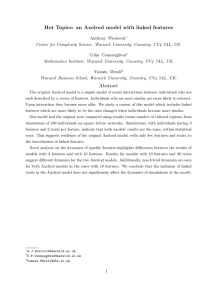Reading to Write
advertisement
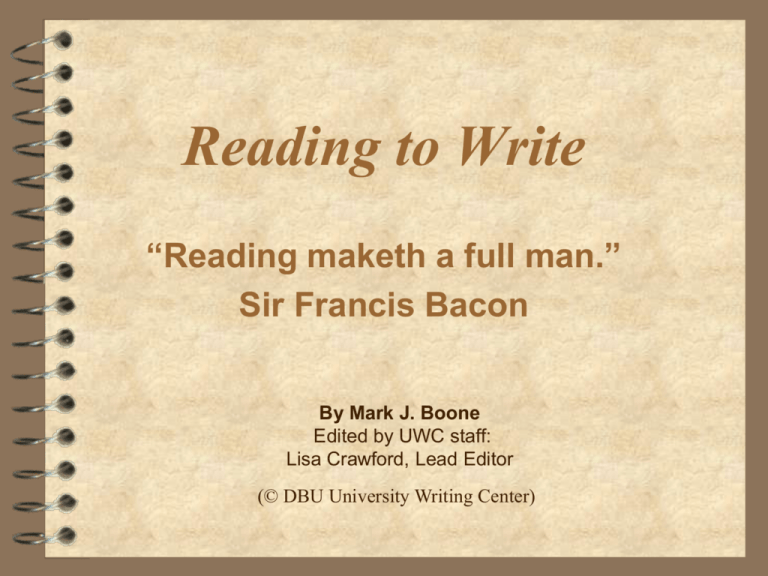
Reading to Write “Reading maketh a full man.” Sir Francis Bacon By Mark J. Boone Edited by UWC staff: Lisa Crawford, Lead Editor (© DBU University Writing Center) Contents I. What does “reading to write” mean?…………………………..slide 3 II. Why read to be a better writer?..................................slides 4-11 III. Practical Steps……….....slides 12-19 IV. What to Read…………..slides 20-22 I. What does “reading to write” mean? “Reading to write” means reading for the purpose of becoming a better writer. This can mean reading a specific book and specifically observing the writing style of an author or genre. However, the fuller definition of “reading to write” includes developing habits not only of reading good books, but also of allowing great books to shape and influence one’s writing style. II. Why read to become a better writer? Like any skill, writing is best learned by studying its masters. There are many reasons why reading is probably the best way to be a good writer: – – – – – – – “Walking with the wise” Composing Eloquence Building vocabulary Recognizing good writing Staying learned and informed Improving thinking skills Improving grammar Walking With the Wise In order to be the best writers they can be, writers study those who have mastered the art of writing. “He who walks with the wise grows wise […]”—Proverbs 13:20 (NIV). When readers walk with the wise writers by reading their books, their own wisdom increases. Their skill affects readers through “osmosis:” if readers immerse themselves in good writing, some of the writers’ talent will seep into them. Composing Eloquence Eloquence is the ability to use words in a clear, engaging, and creative way. Writers can learn eloquence by reading the works of authors whose writing is above or different from every-day writing. Reading things that are interestingly and beautifully written helps writers to write interestingly and beautifully. Building Vocabulary One of the best ways to learn new words is to see them used in the context of a good piece of writing. Seeing a word in context helps in learning the word’s meaning. Recognizing Good Writing As a result of reading good books, writers learn of what good writing consists. They learn how to judge good writing because they know what good writing looks like. Then, not only are writers better equipped to judge what is written in newspapers, books, or elsewhere, but they become better equipped to recognize when their own writing is in need of improvement. Staying Learned and Informed In this era of technology, reading is still the most effective way to know what is going on in the world. This is not just for keeping up with the news: becoming well informed about just about anything requires reading at least one or two good books. Do not forget other sources: whatever one wants to write about, one can probably find information on the internet that is useful for understanding the topic. Improving Thinking Skills Critical thinking skills are improved both by following written arguments and evaluating them. Following the argument allows readers to think about whether or not they agree with the position provided and why. When readers examine an argument, they discover whether or not the argument is logical and what the strengths and weaknesses of the argument are. Knowing what a good argument looks like helps writers when they create their own arguments. Improving Grammar Just by being exposed to good grammar, writers can learn how to use it themselves. The more writers becomes familiar with good grammar through reading, the more it becomes part of their knowledge. III. Practical Steps A quote on reading to write… “Reading critically means not just comprehending passively and remembering what you read but also scrutinizing actively and making thoughtful judgments about your reading. . . you need to alternate between understanding and questioning—on the one hand, striving to understand the text on its own terms; on the other hand, taking care to question its ideas and authority.”1 Rise B. Axelrod and Charles R. Cooper, The St. Martin’s Guide to Writing, sixth edition. (Boston: Bedford/St. Martin’s, 2001), 529. 1 Practical Steps . . . Write down new words: – A good idea for building vocabulary is to immediately look up every unknown word. – Either copy or summarize the dictionary definition onto a notecard or sticky note and hang it up in places where it will be seen during the day. Study sentences: – Observe sentence structure when reading good books. – Also watch the way words are put together into various kinds of sentences when reading good books. Practical steps . . . Observe writing styles: – When reading something of interest, either for pleasure or to later write about, watch what is written to learn how others have written it. – Become immersed in the writing styles particular to subjects of interest to learn how to write similarly. Practical Steps . . . Annotating: – Annotation is “recording your reactions to, interpretations of, and questions about a text as you read it.”2 – The following are strategies for annotating: • • • • Making marks “directly on the page.”3 Underlining important points Highlighting Making notes in the margins 2 Axelrod and Cooper, 529. 3 Axelrod and Cooper, 530. Practical Steps . . . Outlining: – Outlining is “listing the text’s main ideas to reveal how it is organized.”4 – Outlining forces writers to search for the overall flow of a text. – When using this in writing, it helps to clarify thoughts and to make the paper flow. 4 Axelrod and Cooper, 529. Practical Steps . . . Paraphrasing: – Paraphrasing is “restating something you have read using mostly your own words.”5 – Being able to say something in different words shows that one truly understands it. Summarizing: – Summarizing is “a summary is a relatively brief restatement . . . of the reading’s main ideas.”6 – Skills in summarizing will be especially useful in writing introductory and concluding paragraphs. 5 Axelrod and Cooper, 541. 6 Axelrod and Cooper, 542. Practical Steps . . . Synthesizing: – Synthesizing is “integrating into your own writing ideas and information gleaned from different sources.”7 – Synthesizing is cross-referencing different ideas and information from different sources, or comparing the information to bring it together in a meaningful way. – Skills in synthesis of material in different sources are vital when writing a good research paper. 7 Axelrod and Cooper, 529. Practical Steps . . . Evaluating the logic of an argument: – This means “determining whether a thesis is well reasoned and adequately supported.”8 – While reading, improve logical skills through practice by logically testing what is read. – Being able to evaluate logical arguments is a must for writing wellreasoned papers. 8 Axelrod and Cooper, 530. IV. What to Read What should one read to become a better writer? – It is very important to read the right things: good books, respected newspapers, and quality magazines. The more one reads, the more it will help in becoming a better writer. What to Read Be sure to read things of interest. – When one reads something he or she is not interested in, reading becomes boring. – Reading things that hold interest encourages more reading. Writing about subject requires reading about that subject. – This will help in learning the vocabulary specific to a subject as well as the writing styles. – Reading also creates familiarity with major contributors and authors of a topic. Three Suggested Books to Read Dune, by Frank Herbert. If you like sci-fi, try reading this classic sci-fi book and learning all the new vocabulary words you find there (just don’t trust the commas). On Writing Well, by William Zinsser. This book is a guide to writing, but is written in humorous, lively language and doesn’t at all resemble a textbook. Of Mice and Men, by John Steinbeck. Steinbeck uses his words to paint vivid pictures, and his works will expose readers to effective vocabulary and powerful imagery.
